MARIANI’S
Virtual Gourmet
November
4, 2018
NEWSLETTER
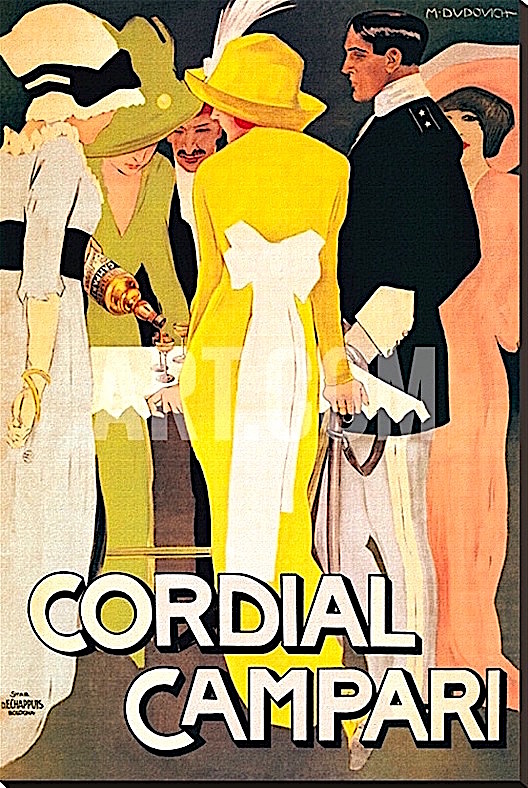
❖❖❖
IN THIS ISSUE
MIAMI, Part Two
By John Mariani
NEW YORK CORNER
CARDONCELLO DIVINO
By John Mariani
NOTES FROM THE WINE CELLAR
TENUTA
SANTA
MARIA HAS ITS EYE ON THE WEATHER
AND ITS MIND ON UPGRADING THE WINES OF THE
VENETO
❖❖❖
MIAMI,
Part Two
By John Mariani
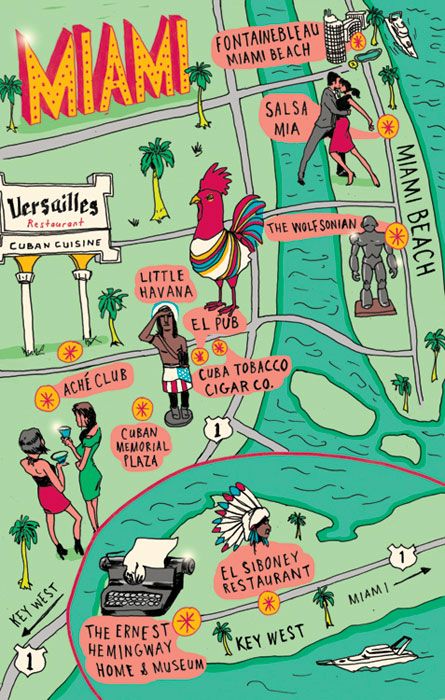
As noted last week, the
real culinary excitement in Miami is happening
across the causeways from Miami Beach, whose
inundation with snowbirds and South Americans
has resulted in little else but buzz-fueled
eateries, with a few exception like Habitat and
Stiltsville, which I wrote about several months
ago. Here are two new restaurants with real
personality and innovation of a kind that would
be welcome in any city.
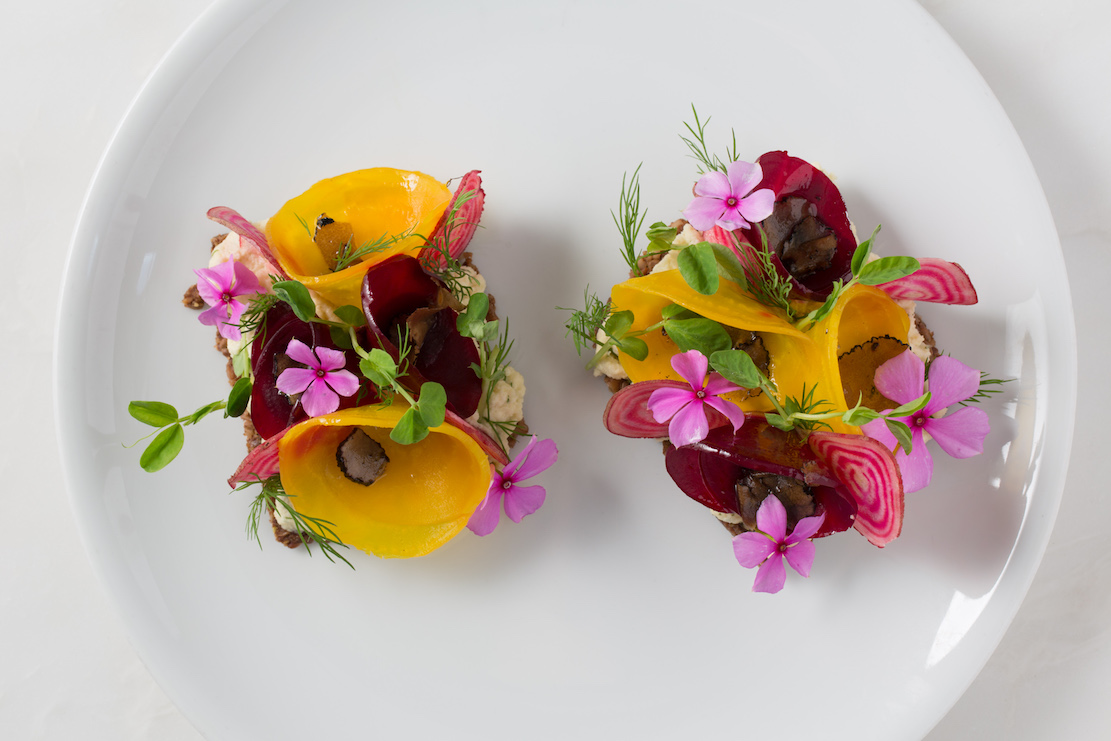 PLANT
MIAMI
PLANT
MIAMI
104 NE 24th Street
305-814-9396
Exterior photo by Gio Alma
If
not exactly kicking and screaming, I was brought
to Plant Miami with a great deal of reluctance by
a friend who swore I needed to keep an open mind.
For Plant Miami is a vegan restaurant that calls
itself “The Sacred Space,” and, while I haven’t
the slightest problem with vegetarian restaurants
or people who choose a vegetarian lifestyle, I
find vegans too often to be proselytizers, even
belligerent towards those who cannot accept their
extreme attitude towards consumption of anything
even vaguely having to do with animal
products—even wine, which may have been filtered
using animal skins. 
But upon arriving at this breezy, casually elegant new restaurant in Wynwood, I didn’t see any staff sporting hemp outfits and no one sneered at my leather belt and shoes. Nor was there any longwinded philosophical explanation of the food. And, just in case I found the food hard to swallow, they did in fact serve wine I could wash it down with.
In the end, I could not have been happier than to dine—and I mean dine, not just munch—at Plant Miami, for most of the food was both delicious and beautifully presented. Outside of some insipid fake “activated cheese” and words like “the Sacred Salad” strewn around the menu, there was nothing you might not find on a regular menu that happened to be among the vegetable dishes.
There on a sunny patio I was as delighted as I was impressed by Chef Horacio Rivadero’s lovely dishes like harvest dumplings with a sweet potato and coconut wrapper and ginger foam ($17). A concentrated confit of papaya with fennel oats and tamari pearls ($17) didn’t need the macadamia “goat’s cheese” but was full of intense flavor.
 Thai
noodles with tamarind and panka, kelp noodles, red
cabbage, carrots, sesame seeds and watercress
($24) had real heft, chewiness and crunch all at
once. “Cacio
di funghi” ($25)—another intentional
misnomer—was actually a bowl of tasty kelp noodles
with a cashew truffle “béchamel,” baby brassica and
truffle “caviar.”
Thai
noodles with tamarind and panka, kelp noodles, red
cabbage, carrots, sesame seeds and watercress
($24) had real heft, chewiness and crunch all at
once. “Cacio
di funghi” ($25)—another intentional
misnomer—was actually a bowl of tasty kelp noodles
with a cashew truffle “béchamel,” baby brassica and
truffle “caviar.”
And, if I didn’t know where I was, I’d swear dessert chef Veronica Manolizi’s Key lime brûlée with an expertly made almond crust and vanilla “ice cream” ($16) was the real deal.
Again, using words like "cheese," "béchamel" and "caviar" here is sheer gimmickry, which Plant Miami does not need when it can produce food of such high caliber. A rose is a rose is a rose, except when it’s made of soy.
Open for lunch and dinner daily.
223 NW 23rd Street
305-573-5996
Three-year-old
Alter is Chef-owner Bradley Kilgore's intent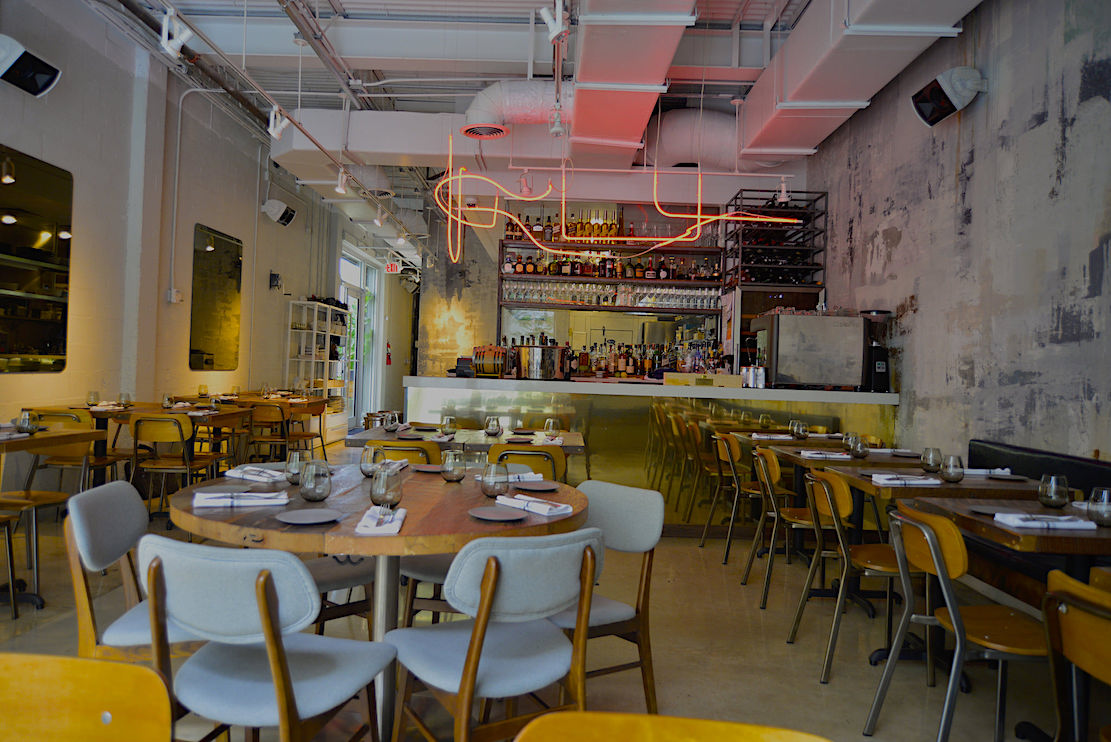 ion to provide the
neighborhood with a very edgy, very loud, very
buzzy restaurant that fits into the curiously
sleepy Design District. The walls are scuffed up
concrete, the ceiling ducts are exposed, the
kitchen wide open and a squiggly neon light is the
rare note of color.
ion to provide the
neighborhood with a very edgy, very loud, very
buzzy restaurant that fits into the curiously
sleepy Design District. The walls are scuffed up
concrete, the ceiling ducts are exposed, the
kitchen wide open and a squiggly neon light is the
rare note of color.
One food magazine says, “Alter is so cool it doesn’t even have to try.” But Kilgore (below, far right) is trying very, very hard to produce a distinctive modernist Asian fusion cuisine that, if too often overwrought, is still tantalizing and mostly delicious, best appreciated in the five-course $75 menu, or the seven-course $95 and nine-course $165 alternatives; à la carte is also available.
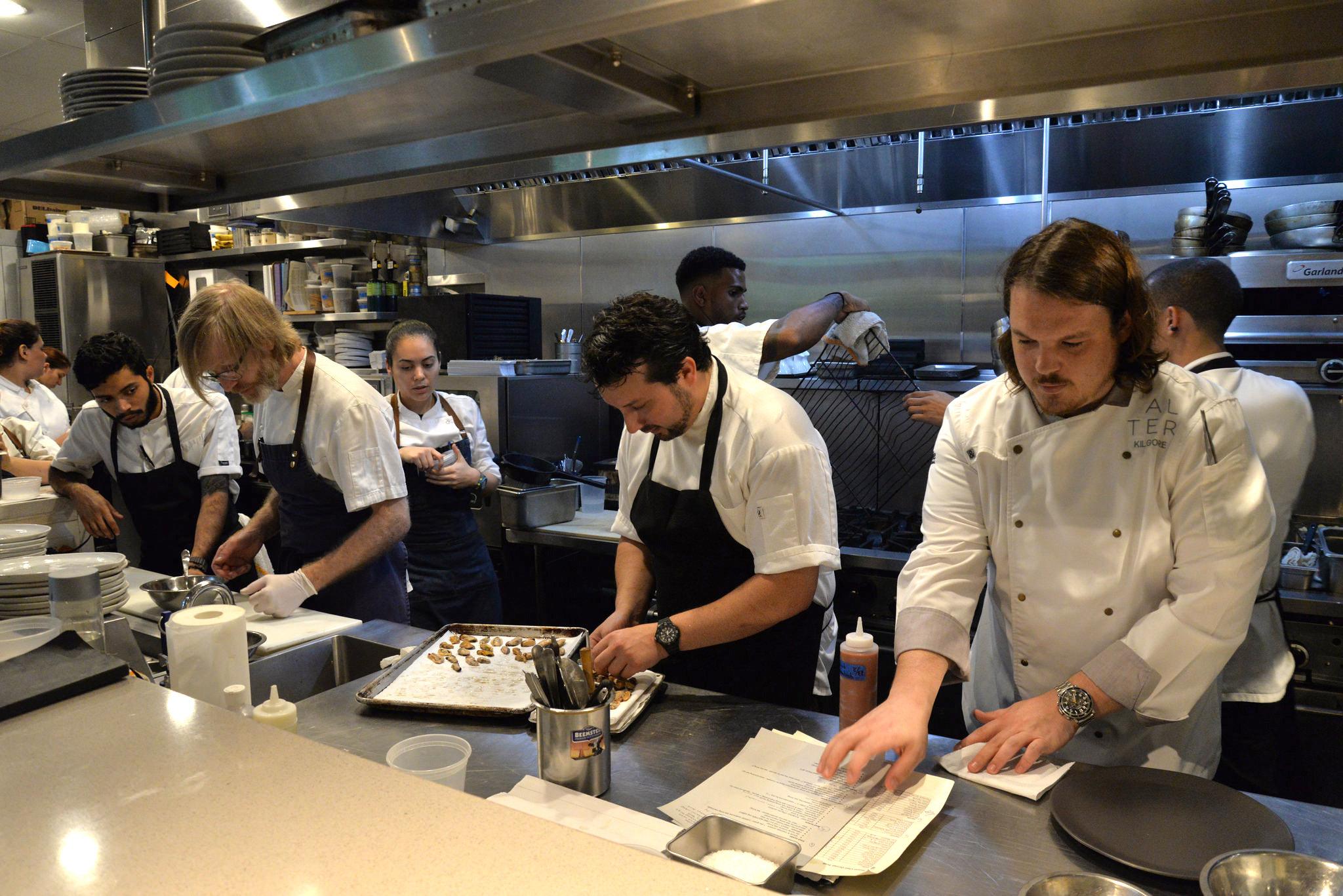 Our
party began with what has become a much talked-about
dish: a soft egg (below,
left) with a sea scallop foam, truffle
pearls and chives ($10/$20), which had the perfect
balance of its elements. If there is such a thing as
umami, this might have it. Grouper cheek (below) with
nicely chewy black rice, sea lettuces, cucumber and
a rich shoyu-laced
hollandaise ($32) was a fine, novel melding, as were
oyster mushrooms with a yuba tofu crisp with sweet soy
glaze and chili threads ($16). Equally fine was duck
breast grilled over pine cones that had been cured
in sake lees,
Our
party began with what has become a much talked-about
dish: a soft egg (below,
left) with a sea scallop foam, truffle
pearls and chives ($10/$20), which had the perfect
balance of its elements. If there is such a thing as
umami, this might have it. Grouper cheek (below) with
nicely chewy black rice, sea lettuces, cucumber and
a rich shoyu-laced
hollandaise ($32) was a fine, novel melding, as were
oyster mushrooms with a yuba tofu crisp with sweet soy
glaze and chili threads ($16). Equally fine was duck
breast grilled over pine cones that had been cured
in sake lees, combined
with banana and shio shiro
ramen ($34).
combined
with banana and shio shiro
ramen ($34).
The nominal appeal of wagyu beef ($70/$85) was overwhelmed by an otherwise savory combination of mole, cobia, smoked bean and beef katsuobushi, made from fermented, smoked and dried tuna.
One of the desserts offered that evening was an odd rendering indeed: whipped caramel with Camembert ice cream, roasted pineapple, marigold honey and bee pollen ($11). Chefs should ask themselves, if no one else had ever thought of piling all those ingredients together on a plate, maybe there’s a good reason.
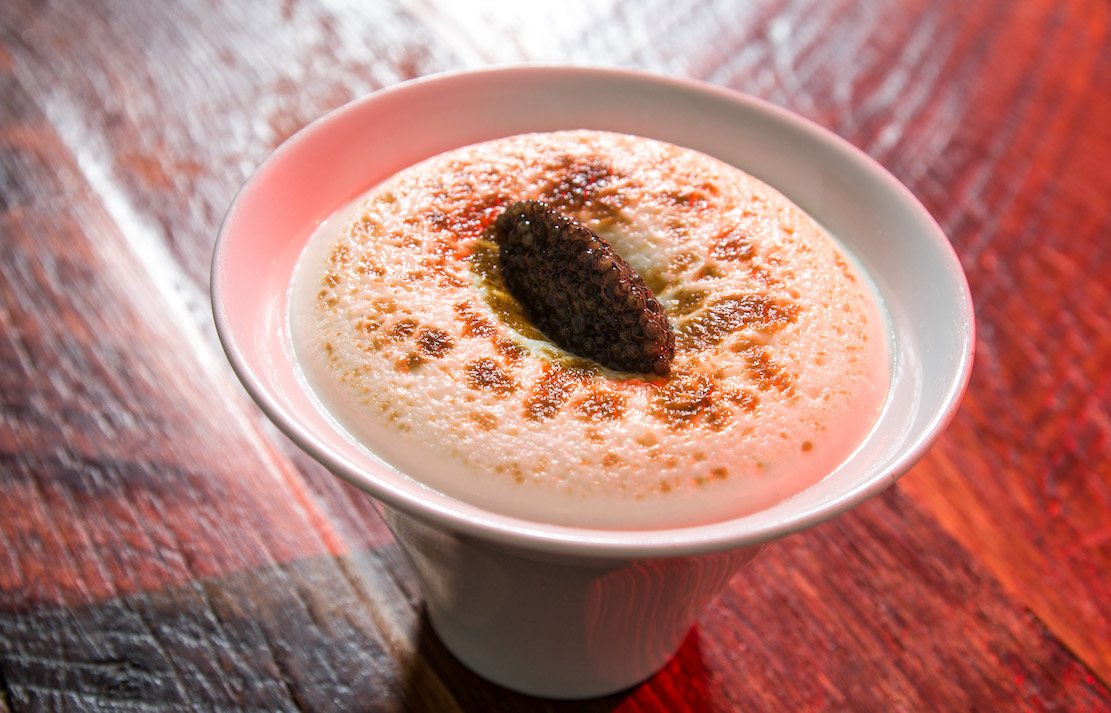 By the way, the eight
bucks for “bread and beurre” with sumac and dill
seed crust and “umami butter” is too much by about
seven dollars.
By the way, the eight
bucks for “bread and beurre” with sumac and dill
seed crust and “umami butter” is too much by about
seven dollars.
Kilgore’s imagination invests every item on his menu—none of it that might be described as Floridian—and his technique rings true. But adding more and more to a dish with tweezers does not make it better, especially when some ingredients cannot really be tasted at all. I suspect he’ll temper his talent soon enough. Miami needs chefs like him to push the envelope.
Open for dinner Tues.-Sat.
❖❖❖
By John Mariani
43 West 27th Street (near Fifth Avenue)
917-409-5995
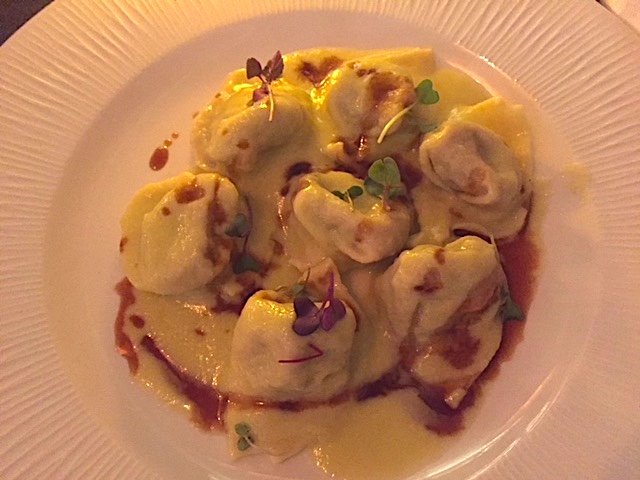
Cardoncello
DiVino is not the first New York
restaurant to be named after a
mushroom—Chanterelle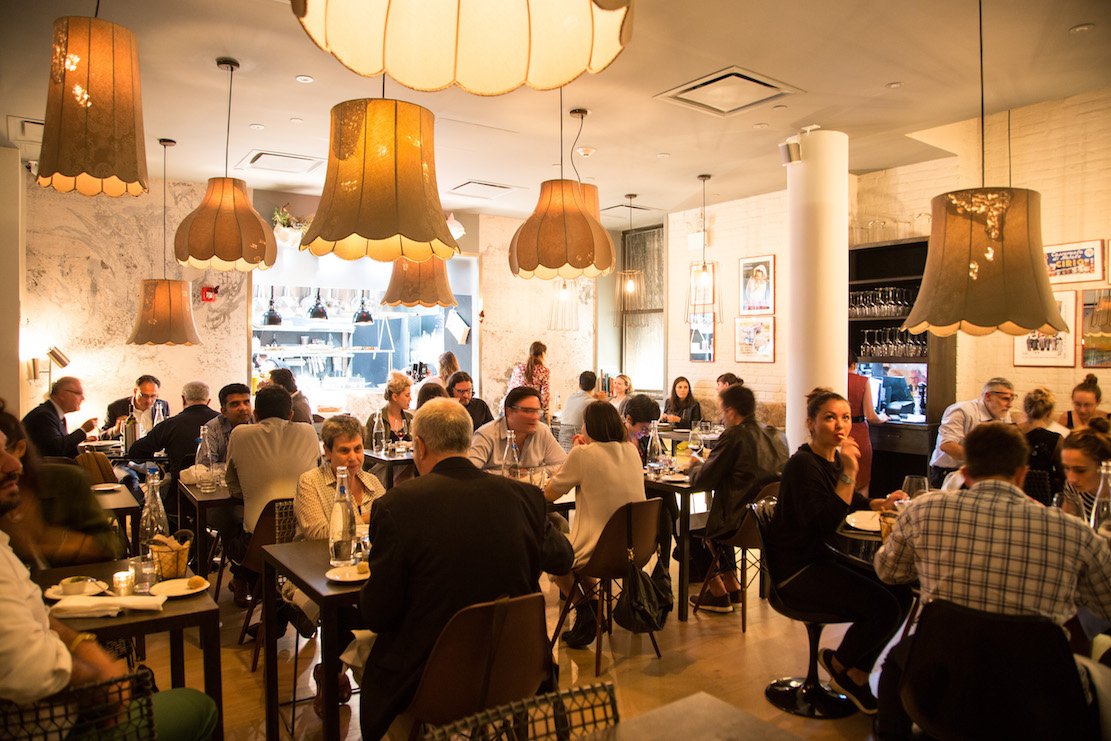 opened in SoHo
back in the 1980s—but the owners of this
fine osteria
in NoMad have added a pun by calling it “divino”
(divine) while capitalizing the V
so that it also refers to wine.
opened in SoHo
back in the 1980s—but the owners of this
fine osteria
in NoMad have added a pun by calling it “divino”
(divine) while capitalizing the V
so that it also refers to wine.
The name derives from the cardoncello
mushroom (Pleurotus
eryngii), which grows at its best in
the Mediterranean region, and the restaurant
has an exclusive importing arrangement to
have them shipped fresh from Puglia every
week. They have a unique flavor, woodsy but
never musty, and they do not shrink in
cooking.
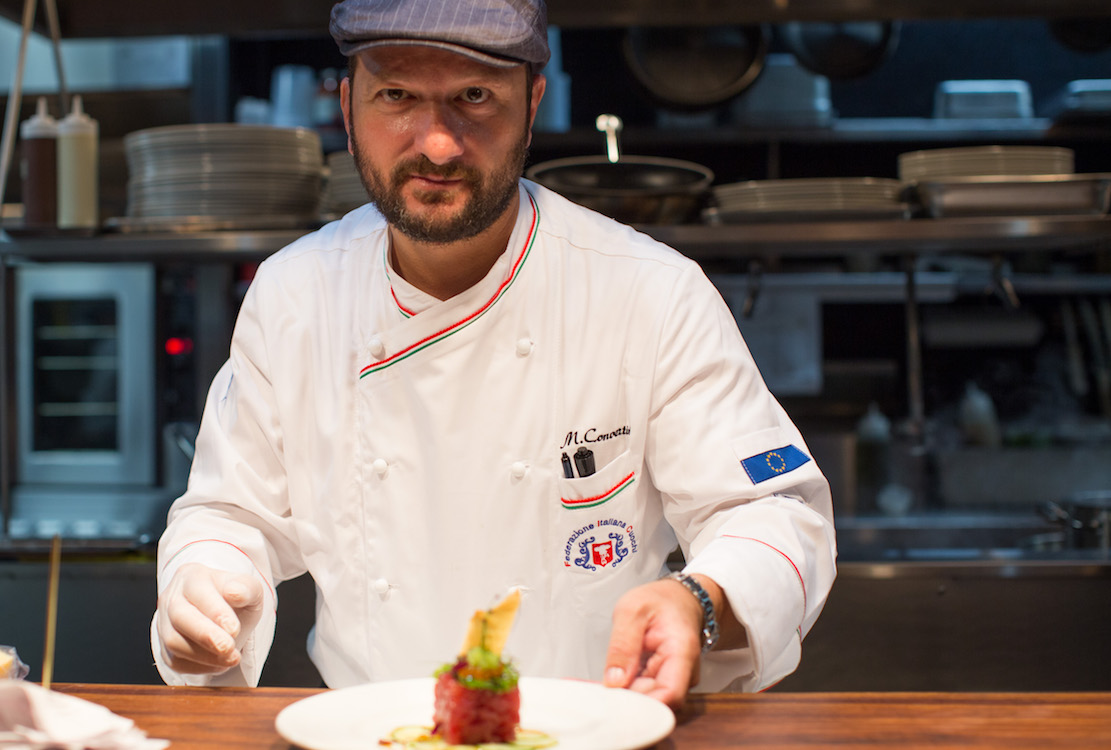 Executive
Chef Max Convertini (left),
formerly of Bottega del Vino in Verona,
calls the fungus “the beating heart of our
restaurant” and mentions its fame as an
aphrodisiac as well as the legend that the
poet Ovid wrote of it with high enthusiasm.
Perhaps.
Executive
Chef Max Convertini (left),
formerly of Bottega del Vino in Verona,
calls the fungus “the beating heart of our
restaurant” and mentions its fame as an
aphrodisiac as well as the legend that the
poet Ovid wrote of it with high enthusiasm.
Perhaps.
While Convertini and chef de cuisine Gianni
Palazzo are very serious about their 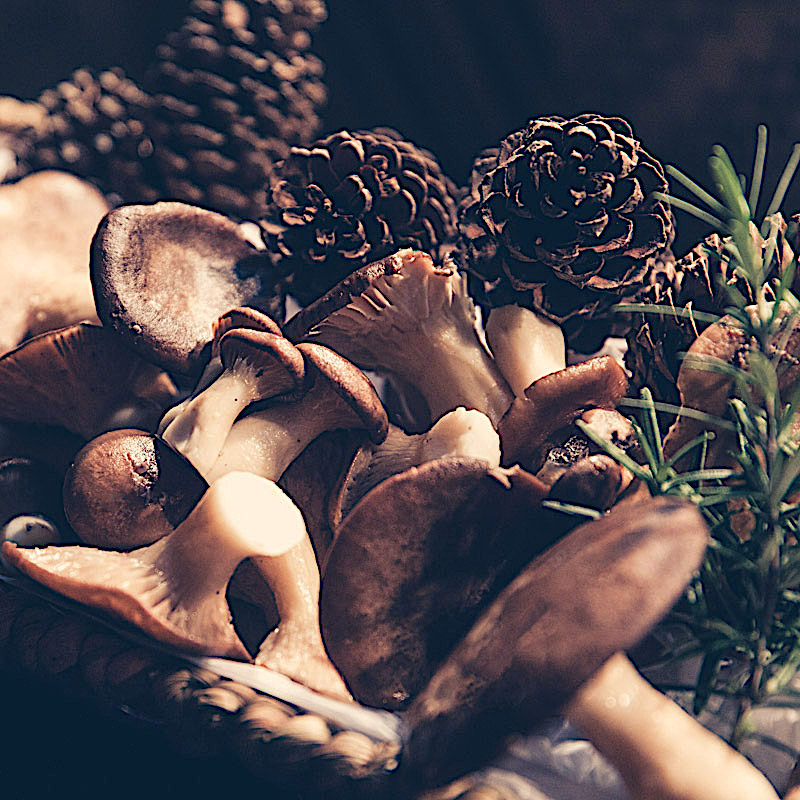 food
and wine, the restaurant’s two rooms have a
rural, rustic feel, provided by designer
Giulia Torregrossa, with off-white brick
walls that reveal flowery images upon close
inspection, floors with faint pastel colored
squares, glowing overhead lighting and an
open kitchen. The ambiance demands guests do
nothing more than enjoy themselves and be
open to new flavors, buoyed by a 150-label
wine list.
food
and wine, the restaurant’s two rooms have a
rural, rustic feel, provided by designer
Giulia Torregrossa, with off-white brick
walls that reveal flowery images upon close
inspection, floors with faint pastel colored
squares, glowing overhead lighting and an
open kitchen. The ambiance demands guests do
nothing more than enjoy themselves and be
open to new flavors, buoyed by a 150-label
wine list.
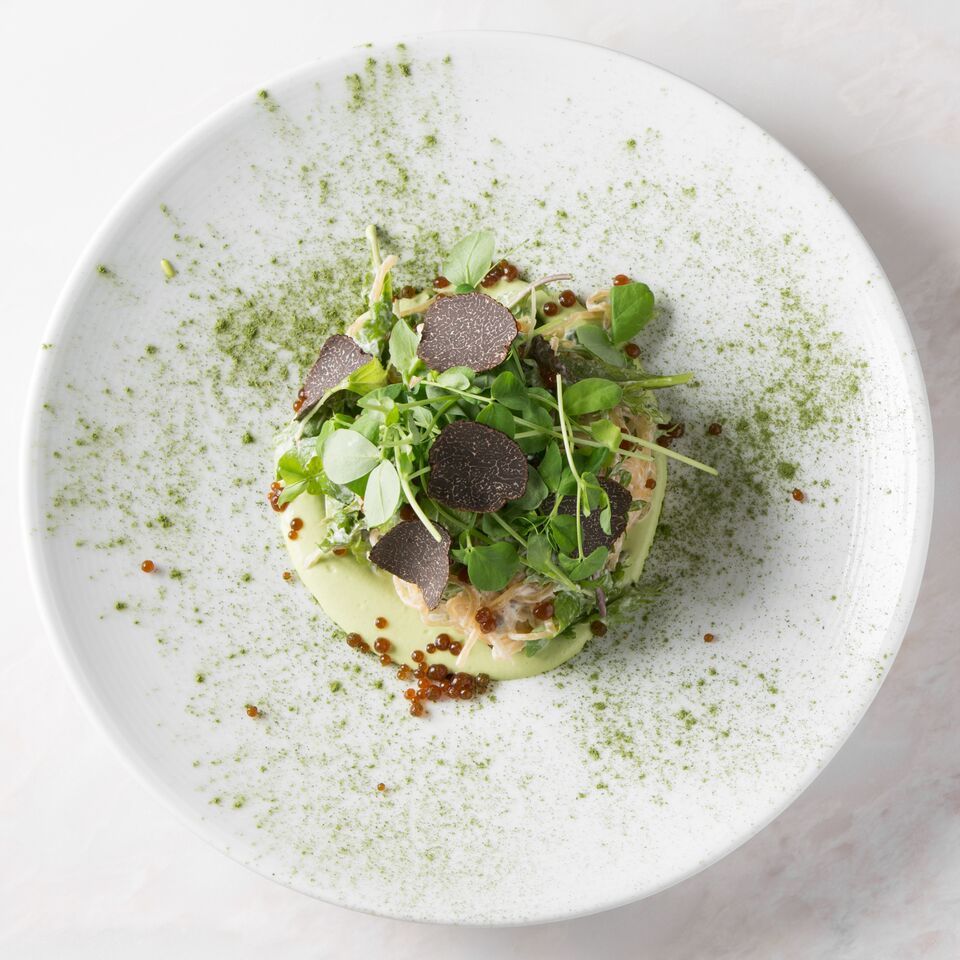 The
best way to begin, then, is at the top of
the menu, with roasted cardoncello
mushrooms (right)
with potato, caciocavallo cheese and
Italian black truffles in a little tart
($17)—or you can get the mushrooms alone as
a side dish ($8)—but I highly recommend the
panelle of chickpea polenta
with tangy goat’s cheese and sautéed shrimp
($15).
You might also consider a tasting of
four olive oils ($18). The bread basket is
very good quality and plentiful.
The
best way to begin, then, is at the top of
the menu, with roasted cardoncello
mushrooms (right)
with potato, caciocavallo cheese and
Italian black truffles in a little tart
($17)—or you can get the mushrooms alone as
a side dish ($8)—but I highly recommend the
panelle of chickpea polenta
with tangy goat’s cheese and sautéed shrimp
($15).
You might also consider a tasting of
four olive oils ($18). The bread basket is
very good quality and plentiful.
Every pasta I tried was wonderful—all
housemade—revealing the ideal texture for
fresh pasta cooked perfectly. Gnudi pumpkin
and ricotta dumplings were dressed with
truffle slices (the white ones will start
coming soon) and a crumble of amaretto
cookies ($17), while plump, tender agnolotti
(below)
enfolded braised beef in a leek fondue with
a Barolo wine reduction ($22). The
twisted pasta shape caserecce,
not often encountered in New York, came with
red onion, pork belly, pecorino and a faint
touch of  housemade
crystallized licorice candy ($17).
housemade
crystallized licorice candy ($17).
Main
courses have heft and deep flavors, from
slowly braised American wagyu beef cheek, cardoncello mushrooms
and shallots served with truffled mashed
potatoes ($29). Admirably fat Colorado
lamb chops came with red endive, wild
onions, wine must and autumn chestnuts
($33)—about as appropriate a dish for
November as you’ll come across right now.
Large shrimp langostini were seared and
sided with orzotto
pasta and a lovely, foamy asparagus fondue
($27).
Share a couple of desserts, like the fat panzotti
(big bellies) stuffed with Nutella,
toasted almonds and licorice, or a light
blueberry cheese cake made with sheep’s milk
and a warm caramel sauce (both $7).
On a Monday night Cardoncello was doing good
business, but was not full, and I suspect
that, when it is, the decibel level will be
very high. So, go early, go on a Monday,
relax and enjoy some of the most enticing
Italian food in the city right now. Max
Convertini is out to enlighten you to his
cooking and maybe even convince you those
mushrooms are aphrodisiacs.
Open for lunch Mon.-Fri., for dinner Mon.-Sat.
❖❖❖
TENUTA
SANTA MARIA HAS ITS EYE ON THE WEATHER AND
ITS MIND ON UPGRADING THE WINES OF THE
VENETO
By John
Mariani
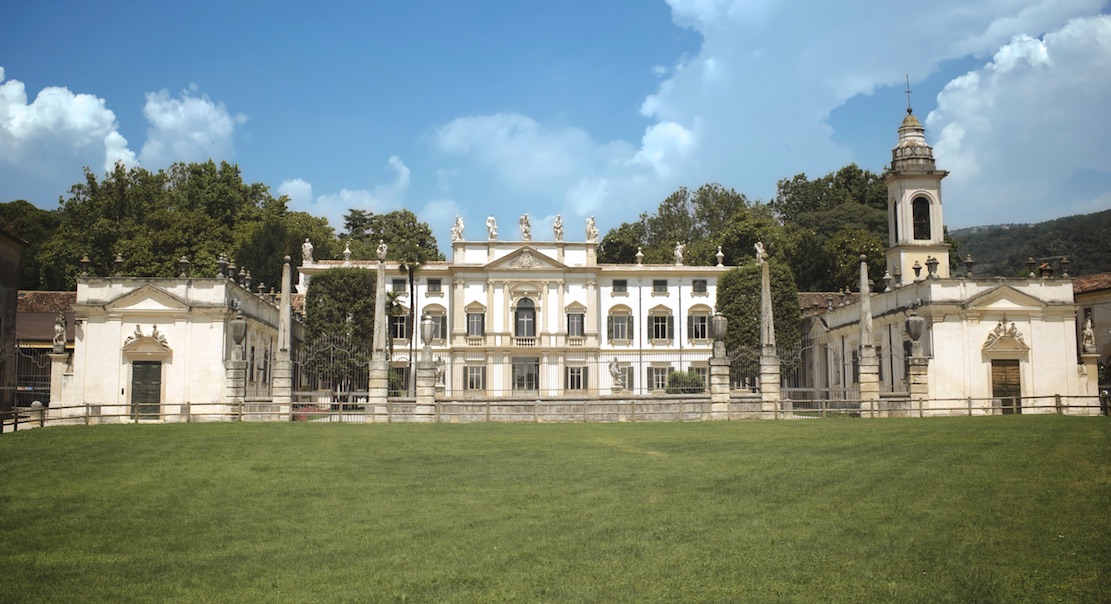
Let me
get some confusion out of the way about the
two Bertani names of Italy’s Veneto region.
The Bertani family founded its first winery
in the 17th century and, by 1857, under
Giovan and Gaetano Bertani, established the
estate as among the region’s finest
producers of traditional Valpolicella, Soave
and Bardolino, beginning exports in the
1860s.
The company was responsible for the first “Ripasso Secco” Valpolicella, a drier, fuller-bodied wine, and in 1959 produced its first Amarone, under the name Gaetano Bertani, who also created a top-of-the-line project from grapes grown in the highly regarded Tenuta Santa Maria property in the Illasi Valley, which they had acquired in the 1850s.
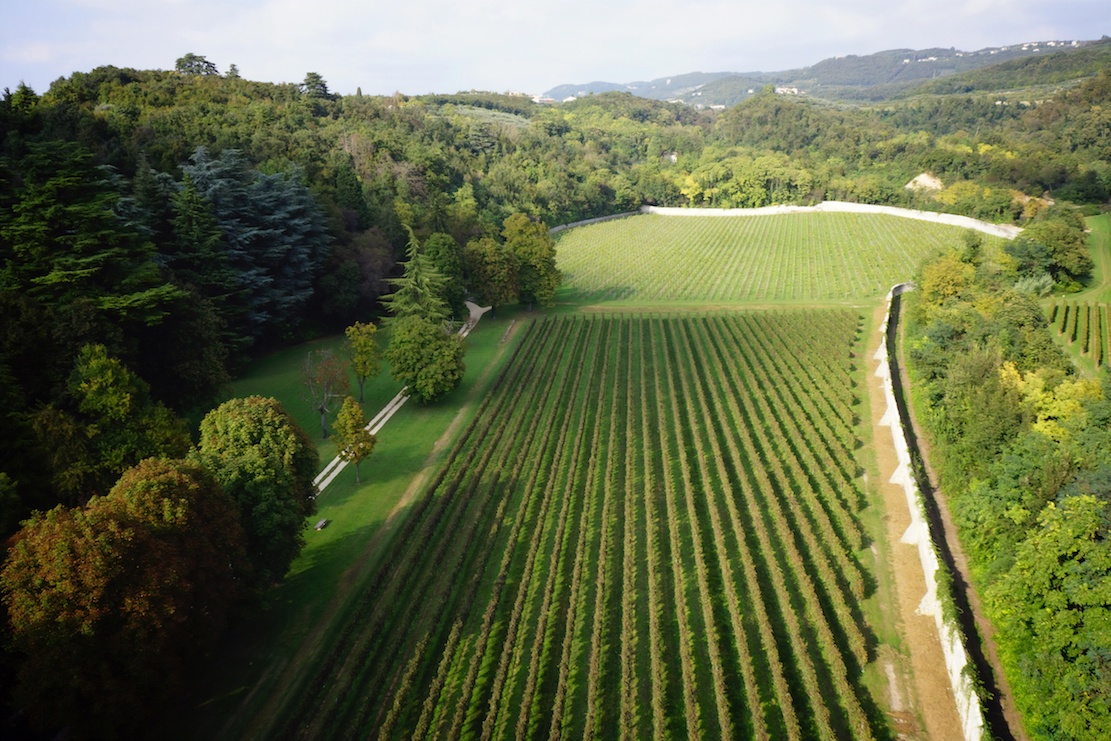 Then,
in 2012, the historic
Bertani company was bought by the Angelini
Group, a Roman Pharmaceutical Company with no
connection to the Bertani family. Gaetano Bertani
and his two sons, Giovanni and Gugliermo,
retained ownership of the Tenuta Santa Maria
estate, but there is no longer any Bertani
family member associated with the old winery.
(Not surprisingly, the new company’s website,
while providing a long history of the estate,
does not mention the absence of the Bertanis.)
Then,
in 2012, the historic
Bertani company was bought by the Angelini
Group, a Roman Pharmaceutical Company with no
connection to the Bertani family. Gaetano Bertani
and his two sons, Giovanni and Gugliermo,
retained ownership of the Tenuta Santa Maria
estate, but there is no longer any Bertani
family member associated with the old winery.
(Not surprisingly, the new company’s website,
while providing a long history of the estate,
does not mention the absence of the Bertanis.)
So, the tradition of the original family winery is being carried on by the current generation, Gaetano and his sons (below). I met Giovanni Bertani last week for dinner at Cardoncello DiVino (see review above) in New York and learned straightaway that in upholding tradition the company is in no way eschewing its strides in modern viniculture. Indeed, global climate changes are causing wineries throughout Europe to re-think a balance that will preserve the old character of their wines while saving them from being affected by the climate heating up.
“We’ve had to move some of our vineyards to
higher elevations because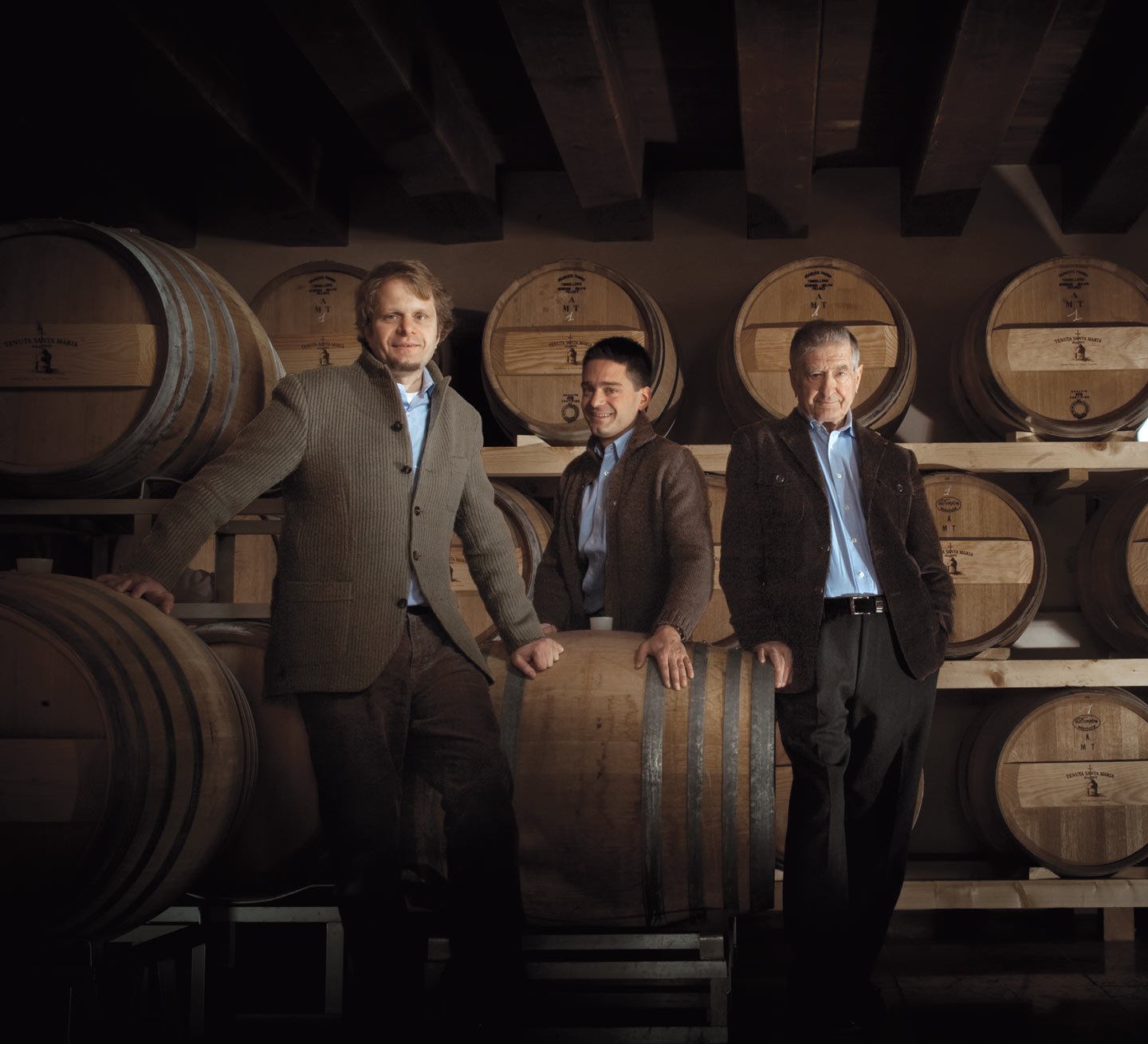 of
the heat,” said Bertani, who looks quite a bit
like an Italian Ed Sheeran. “We’re now picking
the grapes in September, when it used to be in
October. We have to work hard and fast to see
if we can even make our wines the way they
were in the 1930s. It was not just a different
era of wine technology, but the terroir is
being affected now to a degree we cannot yet
measure.”
of
the heat,” said Bertani, who looks quite a bit
like an Italian Ed Sheeran. “We’re now picking
the grapes in September, when it used to be in
October. We have to work hard and fast to see
if we can even make our wines the way they
were in the 1930s. It was not just a different
era of wine technology, but the terroir is
being affected now to a degree we cannot yet
measure.”
Foremost, the problem of too much heat is that it matures the grapes earlier, so the grapes get fat on sugar that turns into high alcohol. Also, no one knows if a temperature change of even half a degree might alter or kill the microbes that have lived in the soil for millennia.
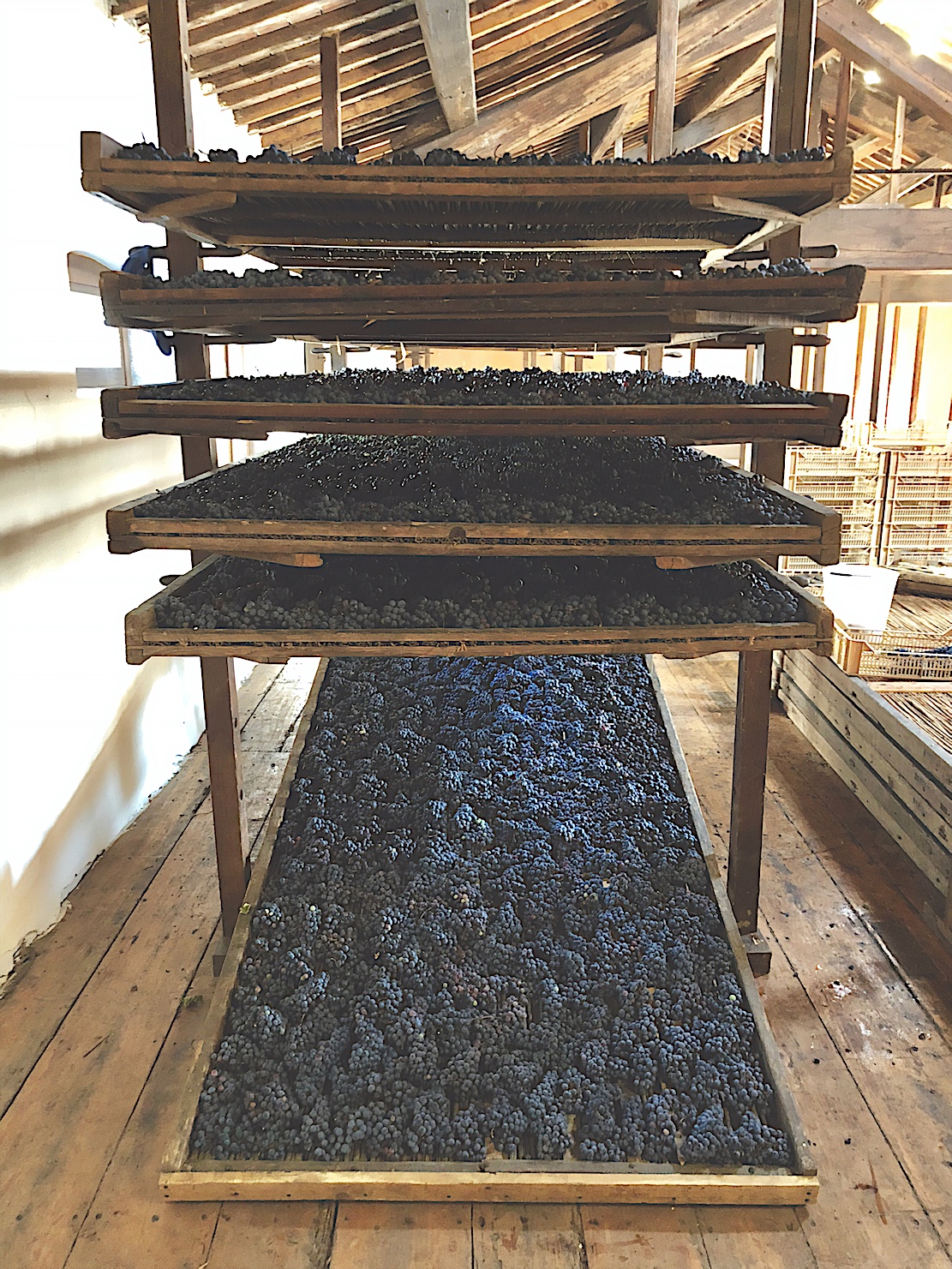 “There
is also the idea that Amarone”—which by
tradition is made by drying Valpolicella
grapes from the upper part of the clusters (left),
concentrating the sugars to make a wine higher
in alcohol and sweetness—“should taste
leathery, even oxidized,” he said, “but that
was because they were not well made. An
Amarone should have good body, but must also
taste fresh and complex.”
“There
is also the idea that Amarone”—which by
tradition is made by drying Valpolicella
grapes from the upper part of the clusters (left),
concentrating the sugars to make a wine higher
in alcohol and sweetness—“should taste
leathery, even oxidized,” he said, “but that
was because they were not well made. An
Amarone should have good body, but must also
taste fresh and complex.”
Over a meal of antipasti and pastas that we
might well have been enjoying in Bertani’s
hometown of Verona, we began with a very
creamy Lepia Soave 2017 ($20), made
from 62-year-old 100% Garganega grapes, whose
richness comes from being left on the lees for
50 days. It went very well with a dish of
chickpea polenta
with tangy goat’s cheese and sautéed shrimp.
Torrepieve 2016 ($35) was a single
vineyard 100% Chardonnay, which is something
of a departure for Bertani, and I wondered if
they were spreading their net too widely in a
Chardonnay-satiated world. Nevertheless,
Bertani’s had the vigorous taste of a Grand
Cru Chablis.
Fifty percent of the crushed grapes
spend 150 days in barrique barrels, the rest
fermented in steel containers. In March of the
year following the harvest, the two wines are
assembled and refined for about six months,
followed by four months in bottle. I was
impressed.
in a
Chardonnay-satiated world. Nevertheless,
Bertani’s had the vigorous taste of a Grand
Cru Chablis.
Fifty percent of the crushed grapes
spend 150 days in barrique barrels, the rest
fermented in steel containers. In March of the
year following the harvest, the two wines are
assembled and refined for about six months,
followed by four months in bottle. I was
impressed.
Pràgal 2016 ($20) is intended as an international wine that “shows the full expression of our region,” he said, made from Corvina, Merlot and Syrah for spice, with some partially dried grapes spending eight months in big barrels (right), although a small amount of the juice does spend time in barriques. It’s an I.G.T. wine that under Italian wine rules cannot get a more localized D.O.C. appellation.
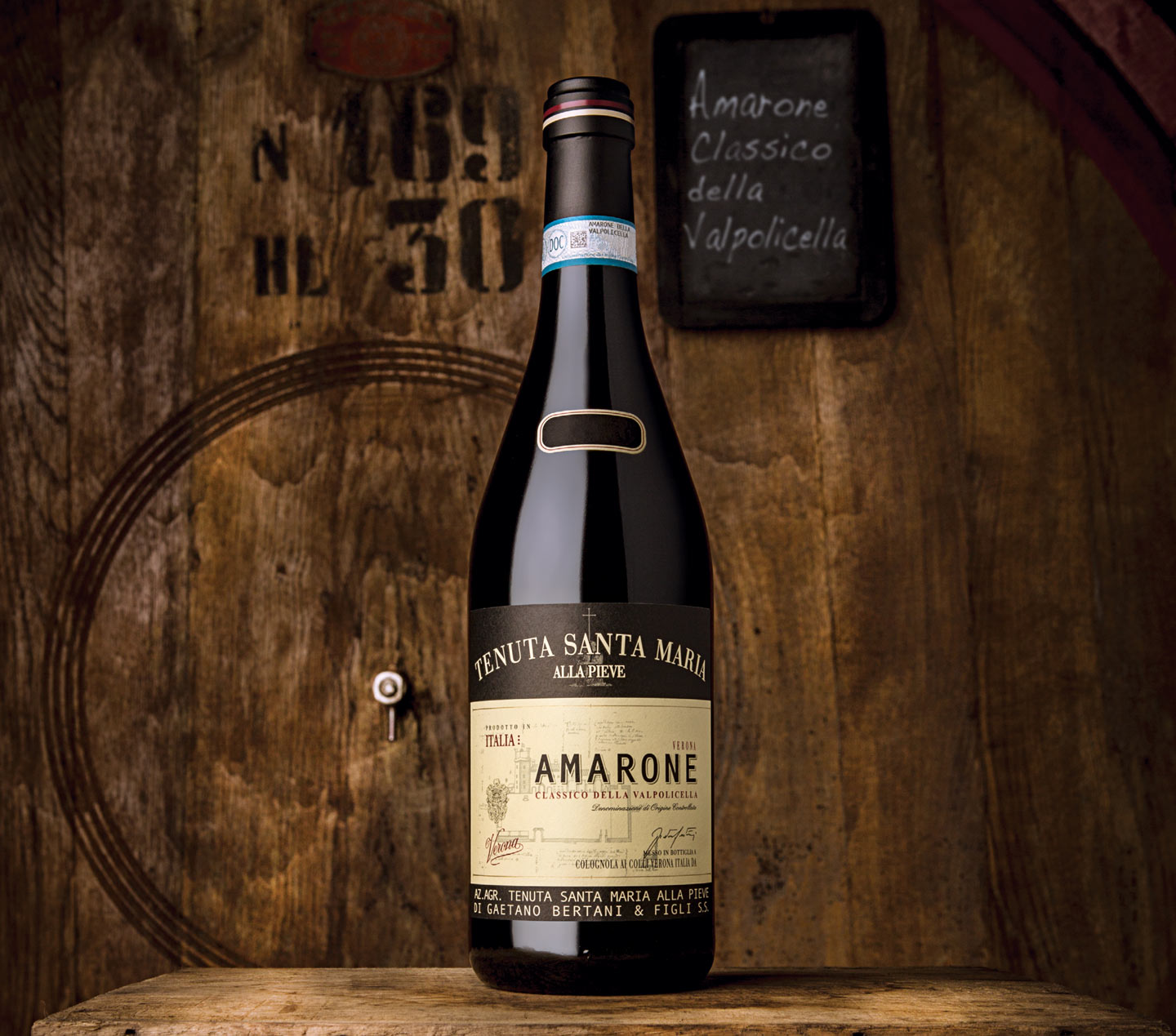 Bertani’s
Valpolicella
Superiore 2016 ($25), from 75% Corvina,
10% Corvinone and 15% Rondinella, at a fine
13.5% alcohol, was a classic style the family
is known for, a distinct balance of fruit and
acid and a wine that fills the mouth with
flavor.
Bertani’s
Valpolicella
Superiore 2016 ($25), from 75% Corvina,
10% Corvinone and 15% Rondinella, at a fine
13.5% alcohol, was a classic style the family
is known for, a distinct balance of fruit and
acid and a wine that fills the mouth with
flavor.
The Amarone 2012 ($90), made from 75% Corvina, 10% Corvinone and 15% Rondinella, was the last of the wines tasted, and it was very clearly made in a modern style, with none of that nostalgic sweetness and oxidation of the past. The grapes were picked mid-September and dried for four months on bamboo and wooden mats. By January 50% of their original weight is lost, and the dried fruit is then pressed to ferment for 25-30 days and fined in large barrels. Five years from the harvest it spends another six months in bottle, emerging at 15% alcohol. It was clean, bright and big bodied without being in anyway cloying or alcohol-dominated, the kind of Veneto wine that can easily rank with the best out of Tuscany and Piedmont.
So while the Bertani name may now belong to a Roman drug company, the break has allowed the current generation of Bertanis to keep their traditions and their style while improving the health of their vineyards and taking on global warming.

“Welcome to
the best party in Wicker Park. On a comparatively
sleepy stretch of North Avenue, this homage to the
Mississippi Delta is so packed it’s practically
shaking, filled with men in ironic mustaches and
women in ironic wire-rimmed glasses, all of them
nodding along to hip-hop and sipping fruity vodka
punches from shareable cut-glass vases.”—Delta Sky
Magazine.
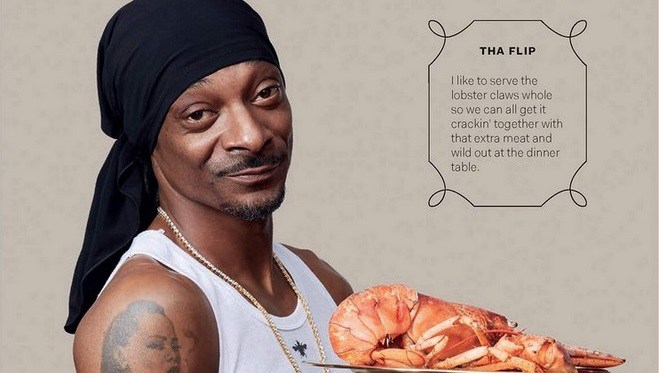 NO, WE DON'T DIG
NO, WE DON'T DIG
Snoop Dogg has published his first cookbook, From Crook to Cook with
recipes for lobster thermidor, easy orange chicken,
fried bologna sandwiches, a gin-and-juice cocktail,
waffles, and other “snacks to satisfy those munchie.”
Says the author, “I’m takin’ the cookbook game higher
with a dipped and whipped collection of my favorite
recipes, ya dig?”
❖❖❖
Wine
Column Sponsored by Banfi Vintners
SANGIOVESE
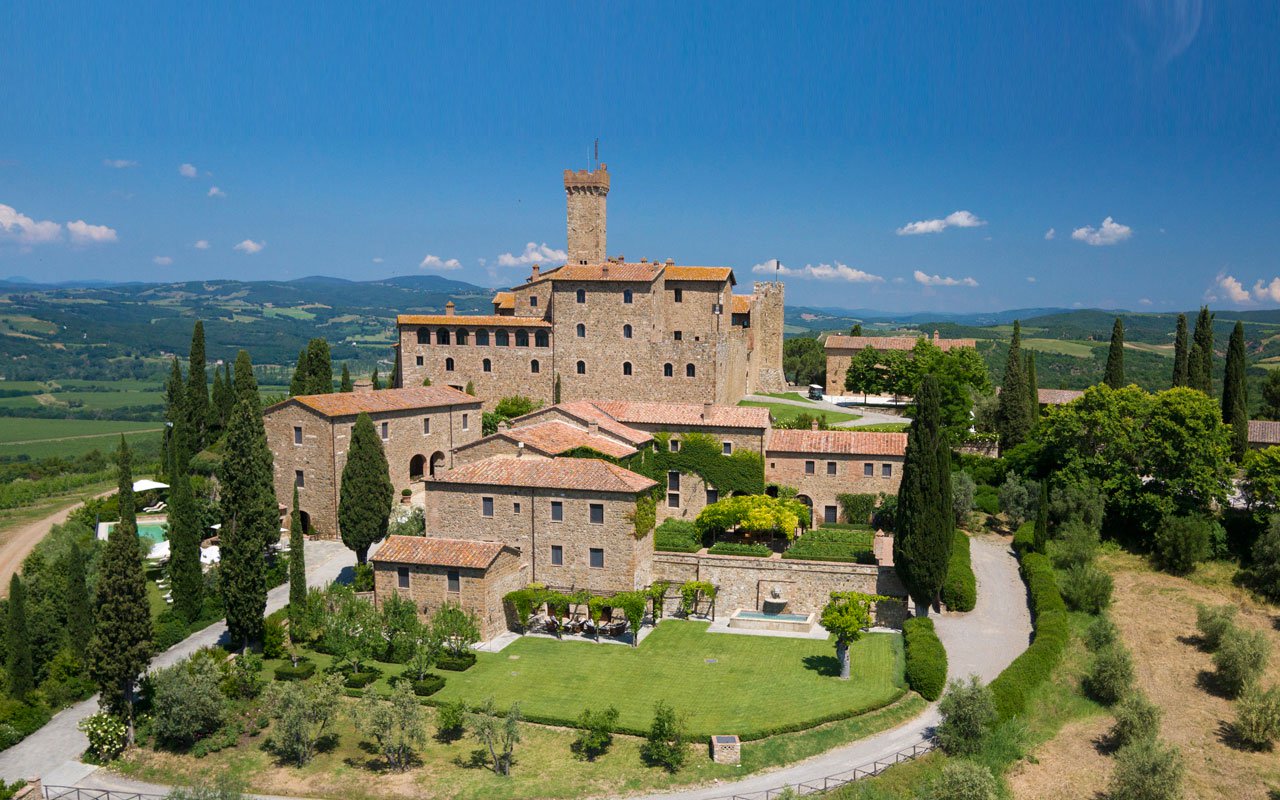 Wine is a joy year-round but
in cooler weather one
grape varietal has really taken center stage in
my daily activities – that most Italian of
grapes, Sangiovese, and its ultimate expression
– Brunello di Montalcino.
Wine is a joy year-round but
in cooler weather one
grape varietal has really taken center stage in
my daily activities – that most Italian of
grapes, Sangiovese, and its ultimate expression
– Brunello di Montalcino.
From mid-September through mid-October,
the Sangiovese grown for our various styles of red
wines are be harvested, culminating with the top
selection for Brunello di Montalcino.
Second, cooler weather here means
it is time to start enjoying more red wines and
especially Sangiovese based wines. That
includes Banfi’s cru of Brunello, Poggio alle Mura,
literally the cream of the crop of our Sangiovese
vineyards. Alongside our Poggio alle Mura Brunello di
Montalcino, this year we introduced two more wines
from the cru Poggio alle Mura – a Rosso di Montalcino
and a Riserva of Brunello. Rosso is sort of like the
younger brother of Brunello, also made from 100%
Sangiovese grapes but usually a selection from younger
vines and the wine is aged only two years compared to
the four required for Brunello. The
Riserva, on the other hand, is an even more selective
harvest of Sangiovese, and ages for an additional year
before release.
What is so special about this cru
Poggio alle Mura?
Well, it is the result our over 30 years of
ongoing research at my family’s vineyard estate,
Castello Banfi.
When we first began planting our vines there in
the late 1970s studies from the University of Bordeaux
indicated which strains of many varietals we should
plant, based on the soil type and microclimate of each
vineyard. But
when it came to the region’s native Sangiovese, there
was only local lore, no scientific research. So we took
it upon ourselves to figure out this vine, and set off
on three decades of incredibly detailed research.
We started
with 600 apparent variations on Sangiovese, because it
is so susceptible to variations in weather and soil,
and narrowed that down to 160 truly genetically
different clones.
We planted a vineyard with two rows of each
type, made wine from each of them, and charted the
differences – remember, you only get one chance a year
to make wine, so this took time.
It took about ten years to get some
concrete results, though we continue to experiment
today and always will – you never stop learning in
science and nature!
Once we determined which were the best,
complementary clones that could be planted together to
make the best Brunello, we chose to plant them in what
we determined to be the optimal vineyard sites. Coincidentally,
the best soils and climate conditions are in the
slopes surrounding the medieval fortress today known
as Castello Banfi, known since Etruscan times as
Poggio alle Mura – the walled hilltop. Hence the
name of our most special “cru” of Brunello,
representing a synthesis between tradition and
innovation.
Though the focus of this study was
our Brunello, all of our Sangiovese-based wines,
including the super Tuscans SummuS, Cum Laude, and
Centine, benefitted from this work. And that’s
the third reason for celebrating Sangiovese this
month, for the range of wonderful reds that usher us
into autumn! One
wine in particular was inspired by our research – the
BelnerO, a Sangiovese dominant blend with what I like
to call a kiss of Cabernet and a whisper of Merlot. We grow the
grapes a little differently for BelnerO than for
Brunello, make the wine with less oak aging and
released it earlier from the winery, providing a
counterpoint to Brunello and a lovely terroir-driven
wine in its own right.
If you
know Italians, you know that by nature we are
multi-faceted, varying in mood, and always passionate. As a
nation, we span from the hot sunny beaches of Sicily
near the African coast to the rugged mountains and
Alpine ski slopes of Trentino-Alto Adige in the north. Sangiovese
is grown in almost all of Italy’s regions and reflects
the unique nature of each; it is most famous
(rightfully so) in Tuscany, yet even there it reflects
the nuances of each hilltop, valley and subzone. It has
something a little different to say in Brunello than
Chianti, Morellino than Vino Nobile di Montepulciano,
Rosso di Montalcino than Super Tuscan blends.
Here is a smattering of
Sangiovese-based wines that you may wish to get to
know better, reflecting a spectrum that appeals to
every occasion, every taste, and every budget. We can
assure you that the conversation will never become
boring. 
Recommendations for Celebrating
Sangiovese
BelnerO Proprietor’s Reserve Sangiovese
– A refined
cuvée of noble red grapes perfected by our pioneering
clonal research. This dark beauty, BelnerO, is
produced at our innovative winery, chosen 11
consecutive years as Italy’s Premier Vineyard Estate.
Fermented in our patented temperature controlled
French oak and aged approximately 2 additional years.
Unfiltered, and Nitrogen bottled to minimize sulfites.
Castello Banfi Brunello di Montalcino –
Rich, round, velvety and intensely
aromatic, with flavor hints of licorice, cherry, and
spices. Brunello di Montalcino possesses an intense
ruby-red color, and a depth, complexity and opulence
that is softened by an elegant, lingering aftertaste.
Unfiltered after 1998 vintage.
Castello Banfi Rosso di Montalcino – Brunello's "younger brother," produced
from select Sangiovese grapes and aged in barrique for
10 to 12 months. Deep ruby-red, elegant, vibrant,
well-balanced and stylish with a dry velvety
finish.
Poggio all’Oro Brunello di Montalcino
Riserva – A single vineyard selection of our most
historically outstanding Sangiovese, aged five years
before release, the additional year more than that
required of Brunello including 6 months in barrel and
6 months more in bottle to grant its “Riserva”
designation. Incredible
elegance and harmony. Intense with lots of fruit and
subtle wood influence. Round, complete, well balanced
with hints of chocolate and berries. Unfiltered after
1998.
Poggio alle Mura – The first tangible result of years of
intensive clonal research on Montalcino’s native
Sangiovese grape.
Estate bottled from the splendidly sun drenched
vineyards surrounding the medieval Castello from which
it takes its name.
The Brunello
di Montalcino is seductive, silky and smoky. Deep ruby
in color with an expressive bouquet of violets, fruits
and berries as well as cigar box, cedar and exotic
spices. The Rosso
di Montalcino is also intense ruby red. The bouquet
is fresh and fruity with typical varietal notes of
cherry and blackberry, enriched by more complex hints
of licorice, tobacco and hazelnut. It is full
bodied, yet with a soft structure, and a surprisingly
long finish. The Poggio alle Mura Brunello di Montalcino
Riserva is deep ruby red with garnet
reflections and a rich, ample bouquet that hints of
prune jam, coffee, cacao and a light balsamic note. It is full
and powerful, with ripe and gentle tannins that make
it velvety and harmonious; this wine is supported by a
pleasing minerality that to me speaks soundly of that
special hillside in southern Montalcino.
SummuS – A wine of towering elegance, SummuS is an
extraordinary blend of Sangiovese which contributes
body; Cabernet Sauvignon for fruit and structure; and
Syrah for elegance, character and a fruity bouquet. An elegant,
complex and harmonious red wine.
Cum Laude – A complex and elegant red which graduated
“With Honors,” characterized by aromas of juicy
berries and fresh spices.
Centine – A Cuvee that is more than half
Sangiovese, the balanced consisting of equal parts of
Cabernet Sauvignon and Merlot. Vinified in
a firm, round style that easily accompanies a wide
range of dishes, this is a smooth and fragrantly
satisfying wine with international character, and a
perennial favorite at my own dinner table.
Banfi Chianti Superiore – The “Superiore” designation signifies
stricter government regulations regarding production
and aging requirements, as compared to regular
Chianti. An
intense ruby red wine with fruit forward aromas and
floral notes. This
is a round wine with well-balanced acidity and fruit.
Banfi Chianti Classico – An enduring classic: alluring
bouquet of black fruit and violets; rich flavors of
cherry and leather; supple tannins and good acidity
for dining.
Banfi Chianti Classico Riserva – Produced from select grapes grown in the
"Classico" region of Chianti, this dry, fruity and
well-balanced red has a full bouquet reminiscent of
violets.
Fonte alla Selva Chianti Classico – This is our newest entry into the Chianti
arena, coming from a 99 acre estate in Castellina, the
heart of the Chianti Classico region. The wine is
a captivating mauve red that smells of cherry, plum
and blackberry with hints of spice. It is
round, full and balanced with very good
acidity.
Col di Sasso – Sangiovese and Cabernet Sauvignon. Luscious,
complex and soft with persistent notes of fruit and
great Italian style structure.
Any of John Mariani's books below may be ordered from amazon.com.
 The Hound in Heaven
(21st Century Lion Books) is a novella, and
for anyone who loves dogs, Christmas, romance,
inspiration, even the supernatural, I hope you'll find
this to be a treasured favorite. The story
concerns how, after a New England teacher, his wife and
their two daughters adopt a stray puppy found in their
barn in northern Maine, their lives seem full of promise.
But when tragedy strikes, their wonderful dog Lazarus and
the spirit of Christmas are the only things that may bring
his master back from the edge of despair.
The Hound in Heaven
(21st Century Lion Books) is a novella, and
for anyone who loves dogs, Christmas, romance,
inspiration, even the supernatural, I hope you'll find
this to be a treasured favorite. The story
concerns how, after a New England teacher, his wife and
their two daughters adopt a stray puppy found in their
barn in northern Maine, their lives seem full of promise.
But when tragedy strikes, their wonderful dog Lazarus and
the spirit of Christmas are the only things that may bring
his master back from the edge of despair. WATCH THE VIDEO!
“What a huge surprise turn this story took! I was completely stunned! I truly enjoyed this book and its message.” – Actress Ali MacGraw
“He had me at Page One. The amount of heart, human insight, soul searching, and deft literary strength that John Mariani pours into this airtight novella is vertigo-inducing. Perhaps ‘wow’ would be the best comment.” – James Dalessandro, author of Bohemian Heart and 1906.
“John Mariani’s Hound in Heaven starts with a well-painted portrayal of an American family, along with the requisite dog. A surprise event flips the action of the novel and captures us for a voyage leading to a hopeful and heart-warming message. A page turning, one sitting read, it’s the perfect antidote for the winter and promotion of holiday celebration.” – Ann Pearlman, author of The Christmas Cookie Club and A Gift for my Sister.
“John Mariani’s concise, achingly beautiful novella pulls a literary rabbit out of a hat – a mash-up of the cosmic and the intimate, the tragic and the heart-warming – a Christmas tale for all ages, and all faiths. Read it to your children, read it to yourself… but read it. Early and often. Highly recommended.” – Jay Bonansinga, New York Times bestselling author of Pinkerton’s War, The Sinking of The Eastland, and The Walking Dead: The Road To Woodbury.
“Amazing things happen when you open your heart to an animal. The Hound in Heaven delivers a powerful story of healing that is forged in the spiritual relationship between a man and his best friend. The book brings a message of hope that can enrich our images of family, love, and loss.” – Dr. Barbara Royal, author of The Royal Treatment.
 |
The Encyclopedia of American Food and Drink by John F. Mariani (Bloomsbury USA, $35) Modesty forbids me to praise my own new book, but let me proudly say that it is an extensive revision of the 4th edition that appeared more than a decade ago, before locavores, molecular cuisine, modernist cuisine, the Food Network and so much more, now included. Word origins have been completely updated, as have per capita consumption and production stats. Most important, for the first time since publication in the 1980s, the book includes more than 100 biographies of Americans who have changed the way we cook, eat and drink -- from Fannie Farmer and Julia Child to Robert Mondavi and Thomas Keller. "This book is amazing! It has entries for everything from `abalone' to `zwieback,' plus more than 500 recipes for classic American dishes and drinks."--Devra First, The Boston Globe. "Much needed in any kitchen library."--Bon Appetit. |
"Eating Italian will never be the same after reading John Mariani's entertaining and savory gastronomical history of the cuisine of Italy and how it won over appetites worldwide. . . . This book is such a tasteful narrative that it will literally make you hungry for Italian food and arouse your appetite for gastronomical history."--Don Oldenburg, USA Today. "Italian
restaurants--some good, some glitzy--far
outnumber their French rivals. Many of
these establishments are zestfully described
in How Italian Food Conquered the World, an
entertaining and fact-filled chronicle by
food-and-wine correspondent John F.
Mariani."--Aram Bakshian Jr., Wall Street
Journal.
"Equal parts
history, sociology, gastronomy, and just
plain fun, How Italian Food Conquered the
World tells the captivating and delicious
story of the (let's face it) everybody's
favorite cuisine with clarity, verve and
more than one surprise."--Colman Andrews,
editorial director of The Daily
Meal.com. "A fantastic and fascinating
read, covering everything from the influence
of Venice's spice trade to the impact of
Italian immigrants in America and the
evolution of alta cucina. This book will
serve as a terrific resource to anyone
interested in the real story of Italian
food."--Mary Ann Esposito, host of PBS-TV's
Ciao
Italia. "John Mariani has written the
definitive history of how Italians won their
way into our hearts, minds, and
stomachs. It's a story of pleasure over
pomp and taste over technique."--Danny Meyer,
owner of NYC restaurants Union Square
Cafe, The Modern, and Maialino.
|
 |
 |
 |
 |
 |
 |
 |
 |
 Everett Potter's Travel Report:
Everett Potter's Travel Report: 
 Eating Las Vegas
JOHN CURTAS has been covering the Las Vegas
food and restaurant scene since 1995. He is
the co-author of EATING LAS VEGAS – The 50
Essential Restaurants (as well as
the author of the Eating Las Vegas web site: www.eatinglasvegas.
He can also be seen every Friday morning as
the “resident foodie” for Wake Up With the
Wagners on KSNV TV (NBC) Channel 3 in
Las Vegas.
Eating Las Vegas
JOHN CURTAS has been covering the Las Vegas
food and restaurant scene since 1995. He is
the co-author of EATING LAS VEGAS – The 50
Essential Restaurants (as well as
the author of the Eating Las Vegas web site: www.eatinglasvegas.
He can also be seen every Friday morning as
the “resident foodie” for Wake Up With the
Wagners on KSNV TV (NBC) Channel 3 in
Las Vegas.
MARIANI'S VIRTUAL GOURMET
NEWSLETTER is published weekly. Publisher: John Mariani. Editor: Walter Bagley. Contributing Writers: Christopher Mariani,
Robert Mariani, Misha Mariani, John A. Curtas, Gerry Dawes, Geoff Kalish,
and Brian Freedman. Contributing
Photographer: Galina Dargery. Technical
Advisor: Gerry
McLoughlin.
If you wish to subscribe to this
newsletter, please click here: http://www.johnmariani.com/subscribe/index.html
© copyright John Mariani 2017

